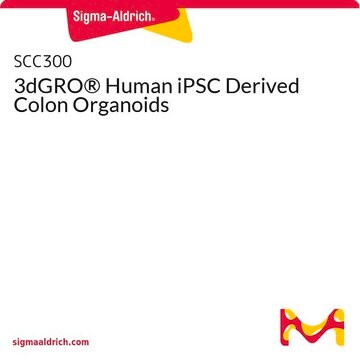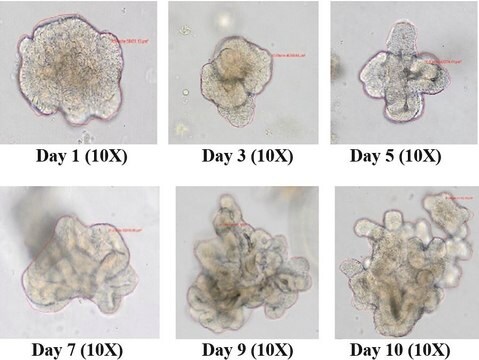SCM162
DMEM/F-12 PLUS Basal Medium
Advanced DMEMF12 basal media used in low-serum or serum-free media formulations including stem cell and 3D organoid cell cultures.
Synonim(y):
Advanced DMEM/F12, Organoid Basal Media, Organoid Basal Media, DMEMF12, DMEM F12, Dulbecco′s Modified Eagle Medium/Ham′s F-12, Serum-Free Basal Media
Wybierz wielkość
355,00 zł
Przewidywany termin wysyłki03 lutego 2025Szczegóły
Wybierz wielkość
About This Item
355,00 zł
Przewidywany termin wysyłki03 lutego 2025Szczegóły
Polecane produkty
Formularz
liquid
metody
cell culture | stem cell: suitable
Opis ogólny
• Culture of primary, stem cells and cell lines in applications that require reduced or serum-free medium.
• Optimization of transfections that require reduced or serum-free conditions.
• Production of conditioned medium in reduced serum or serum-free conditions.
• Optimized media for the culture and expansion of multiple 3D organoids and tissues systems.
DMEM/F12 PLUS is a proprietary formulation that contains human serum albumin (HSA), defined lipids, trace elements, chemicals and proteins essential for optimal cell growth in reduced serum conditions. The media contains high-glucose and does not contain L-glutamine or penicillin-streptomycin.
Zastosowanie
Stem Cell Research
Jakość
Osmolality: 290-330 mOsm
pH: 7.2-7.4
Sterility Tested: No Growth/Pass
Endotoxin: <2 EU/mL
Mycoplasma: Negative
Przechowywanie i stabilność
Oświadczenie o zrzeczeniu się odpowiedzialności
Kod klasy składowania
12 - Non Combustible Liquids
Klasa zagrożenia wodnego (WGK)
WGK 1
Temperatura zapłonu (°F)
Not applicable
Temperatura zapłonu (°C)
Not applicable
Wykazy regulacyjne
Wykazy regulacyjne dotyczą głównie produktów chemicznych. Można w nich podawać ograniczoną liczbę informacji na temat produktów niechemicznych. Brak wpisu oznacza, że żaden ze składników nie znajduje się w wykazie. Użytkownik odpowiada za zagwarantowanie bezpiecznego i zgodnego z prawem stosowania produktu.
EU REACH Annex XVII (Restriction List)
Certyfikaty analizy (CoA)
Poszukaj Certyfikaty analizy (CoA), wpisując numer partii/serii produktów. Numery serii i partii można znaleźć na etykiecie produktu po słowach „seria” lub „partia”.
Masz już ten produkt?
Dokumenty związane z niedawno zakupionymi produktami zostały zamieszczone w Bibliotece dokumentów.
Klienci oglądali również te produkty
Produkty
Human pancreatic cancer organoid biobank (PDAC organoids) with various KRAS mutations to aide in 3D cell culture and cancer research applications.
Organoid culture FAQs. Learn how to culture and analyze organoids following established 3D cell culture protocols. Tips and tricks.
Najczęściej zadawane pytania dotyczące hodowli organoidów. Dowiedz się, jak hodować i analizować organoidy zgodnie z ustalonymi protokołami hodowli komórek 3D. Wskazówki i porady.
Organoid culture products to generate tissue and stem cell derived 3D brain, intestinal, gut, lung and cancer tumor organoid models.
Protokoły
Jak wybarwiać organoidy? Kompletny protokół krok po kroku do barwienia immunofluorescencyjnego (IF) i immunocytochemicznego (ICC) hodowli organoidów przy użyciu przeciwciał
A rapid in vitro assay for CFTR function, the forskolin-induced swelling protocol uses human colon organoids, which can be derived from cystic fibrosis patient tissue.
How to stain organoids? A complete step-by-step protocol for immunofluorescent (IF) and immunocytochemical (ICC) staining of organoid cultures using antibodies
Powiązane treści
Monitor barrier formation using colon PDOs, iPSC-derived colon organoids, Millicell® cell culture inserts, and the Millicell® ERS. 3.0.
Active Filters
Nasz zespół naukowców ma doświadczenie we wszystkich obszarach badań, w tym w naukach przyrodniczych, materiałoznawstwie, syntezie chemicznej, chromatografii, analityce i wielu innych dziedzinach.
Skontaktuj się z zespołem ds. pomocy technicznej








